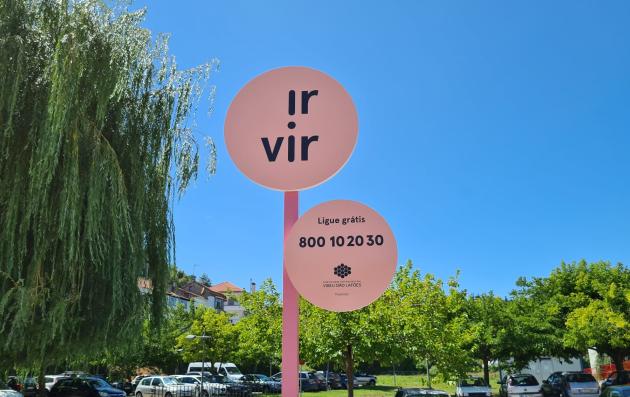Date of label : 29/10/2024
-
Intermunicipal Community of Viseu Dão Lafões , Portugal
-
Size of city : 252.777 inhabitants

The image captures a signpost in a public area, likely intended to raise awareness or promote a specific campaign or service.
Summary
Comings and Goings (Ir e Vir in Portuguese) is a joint initiative aimed at providing new mobility options for the inhabitants of the Viseu Dão Lafões region (PT), involving 13 municipalities. This flexible on-demand transport service overcomes the limitations of conventional public transport in isolated and low-density areas. It increases accessibility and strengthens the coverage of the existing transport network. The Comings and Goings service allows residents to book cabs by calling a reservation centre for free. The service operates only when a booking is made, travelling to prearranged stops at set times. The fare for the service is equal to the price of a bus ticket for the same distance, ensuring affordable pricing.
The solutions offered by the Good Practice
The region of Viseu Dão Lafões has dozens of scattered villages with less than 40 inhabitants, while almost one third of its population is over 65 years old. Due to the limited connection of these areas, many residents, especially the elderly, have trouble accessing public transport.
Comings and Goings operates as a flexible public transportation service in the region of Viseu Dão Lafões. Passengers call a free number to book their trip the day before. An operator assists them with their reservation and any enquiries. The service offers flexible routes and designated stops. Passengers must choose from the available schedule, and can only select a stop if no other public transport is available during that time.
This flexible transportation service uses taxis with a visible logo. The advance booking system allows drivers to optimise routes.
By matching the fare of a bus ticket for equivalent distances, the service is financially feasible for all residents across the region. Since 2022, 23 000 passengers have benefited from the Comings and Goings service, travelling over 260 000 km. Thanks to this initiative, users can rely on efficient and accessible transport for commuting, running errands, and accessing public services.
Building on the sustainable and integrated urban approach
Comings and Goings provides an integrated mobility solution for remote areas with poor connections to urban areas. Routes are optimised based on bookings made the previous day, ensuring the efficiency and environmental sustainability of the practice.
Fares are set to match equivalent bus tickets for similar distances, making the service accessible for people on low incomes. This affordability allows residents to have better access to job opportunities, healthcare, and other essential services without financial constraints.
As a result, the initiative fosters social cohesion by connecting remote communities to the broader urban network, and improves mobility and quality-of-life for social groups at risk and elderly people in rural areas.
Based on participatory approach
Comings and Goings (Ir e Vir) supports the Strategic Plan “Viseu Dão Lafões 2030” by fostering social cohesion, sustainable mobility, and better access to services for residents in isolated areas.
In 2021, six municipalities in the Viseu Dão Lafões region launched a pilot Comings and Goings project. It was the result of long-term cooperation among local governments, community stakeholders, and residents, to address transportation challenges in remote rural areas. The pilot demonstrated the initiative's efficiency and flexibility, reaching 4 500 users in six months.
In 2022, the service was expanded to include 13 municipalities: Aguiar da Beira, Carregal do Sal, Castro Daire, Mangualde, Nelas, Oliveira de Frades, Penalva do Castelo, Santa Comba Dão, São Pedro do Sul, Sátão, Tondela, Vila Nova de Paiva, Viseu and Vouzela.
Collaborative efforts were vital for providing mobility solutions in sparsely populated, remote areas.
What difference has it made?
The Comings and Goings (Ir e Vir) initiative has greatly improved mobility in remote rural areas within the region of Viseu Dão Lafões. By providing reliable and flexible transportation, the daily lives of residents and their access to essential services have been improved.
The expansion of the service to serve 13 municipalities in the region provides solid proof of its success. Facilitating 23 000 journeys over two years is a significant achievement relative to the region's population of 252 000.
Moreover, the growth from 22 collaborating taxi drivers during the pilot phase to 70 today, highlights the capacity to meet growing demand and offer an effective response to local mobility needs.
Why this Good Practice should be transferred to other cities
The practice can be replicated in many European cities that struggle to ensure accessibility and mobility options for residents in peripheral rural areas.
Comings and Goings is an initiative that directly contributes to policy agendas, mainly:
- Sustainable Development Goals (SDGs), particularly SDG 10 (Reduced inequalities) and SDG 11 (Sustainable cities and communities).
- EU Mobility Strategy, by making public transport affordable and accessible for all, and improving connections with rural and remote areas.
- Long-Term Vision for EU’s rural areas, by providing new transport links in remote rural areas.
- Urban Agenda for the EU.
- EU Territorial Agenda 2030.
The initiative was launched as a result of the Strategic Plan “Viseu Dão Lafões 2030”, which is aligned with the national strategy Portugal 2030. This strategic alignment makes the practice highly transferable.
The practice is easily adaptable to other cities with poor connections to surrounding isolated rural areas. The flexible on-demand transport model can be tailored to local needs and infrastructure, by customising routes, schedules and services.
The practice could be transferred to many other territories and has the potential to achieve significant impacts with minimal resources. It comprises a management system for booking and optimising routes, two full-time operators, and collaborations with local drivers.
Establishing cooperation with neighbouring municipalities is crucial to ensure territorial coverage.
